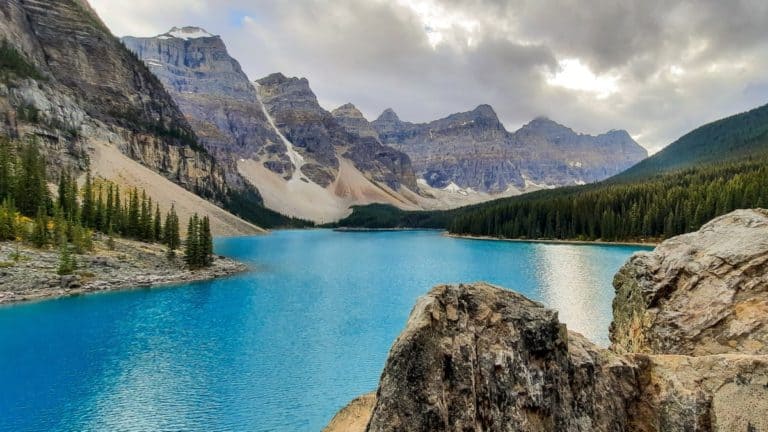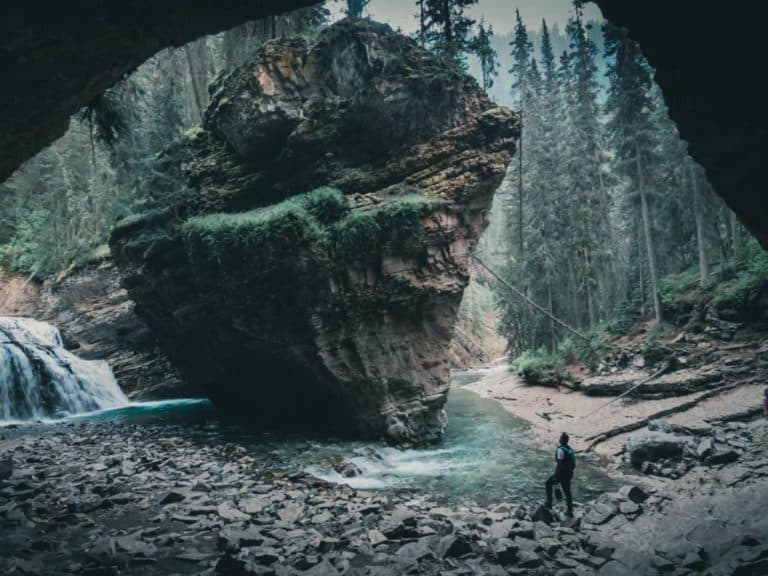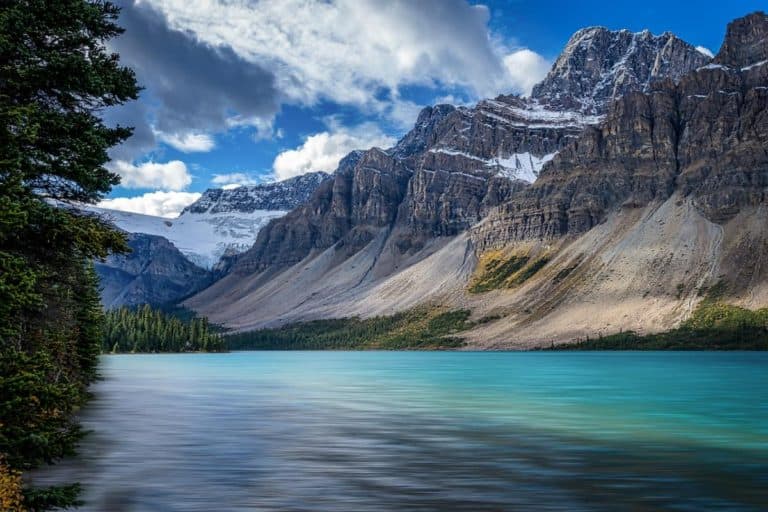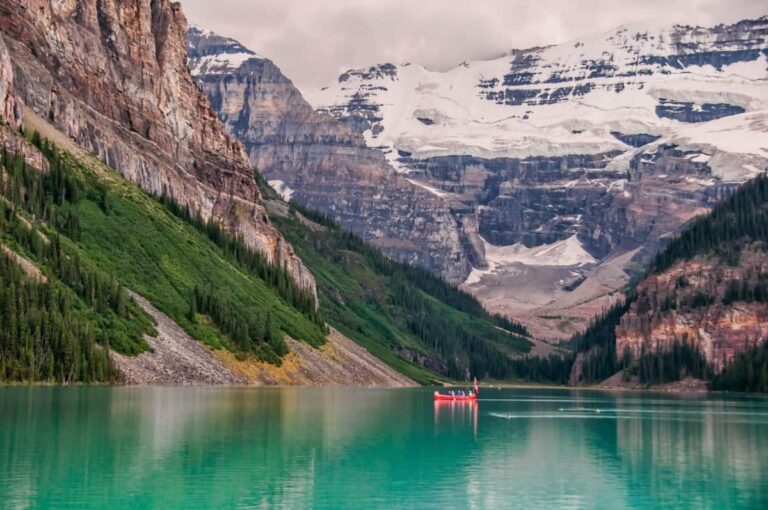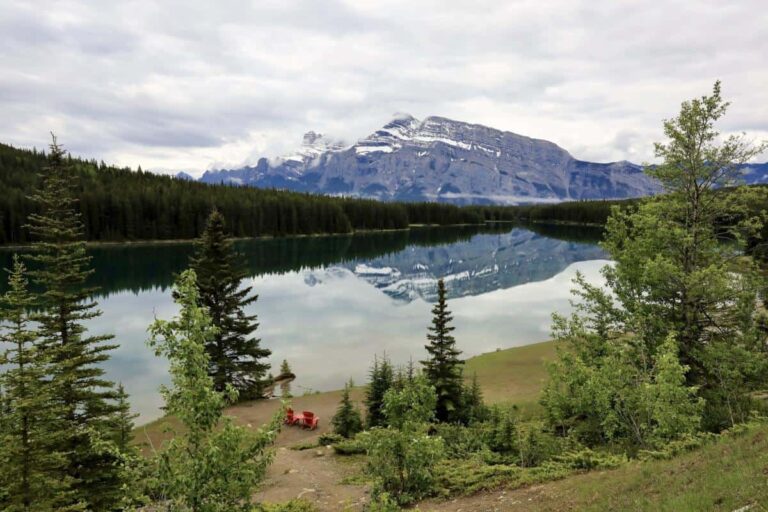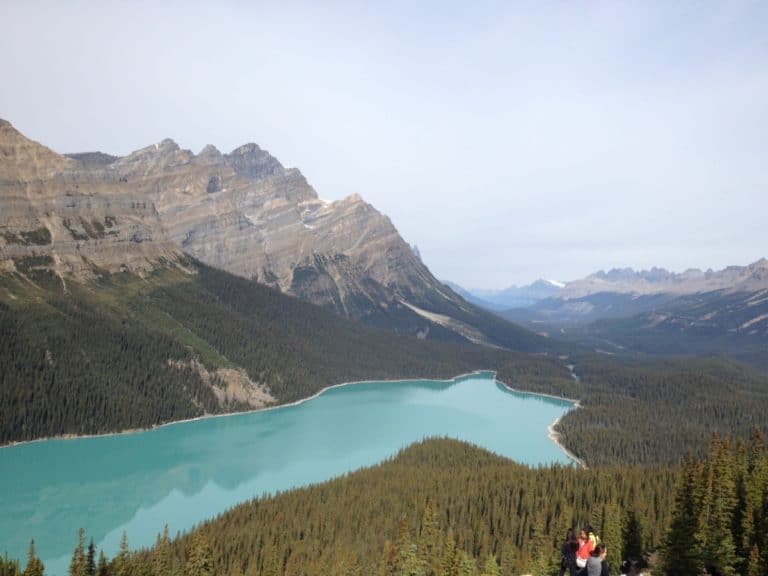The Ultimate Guide to the Town of Banff
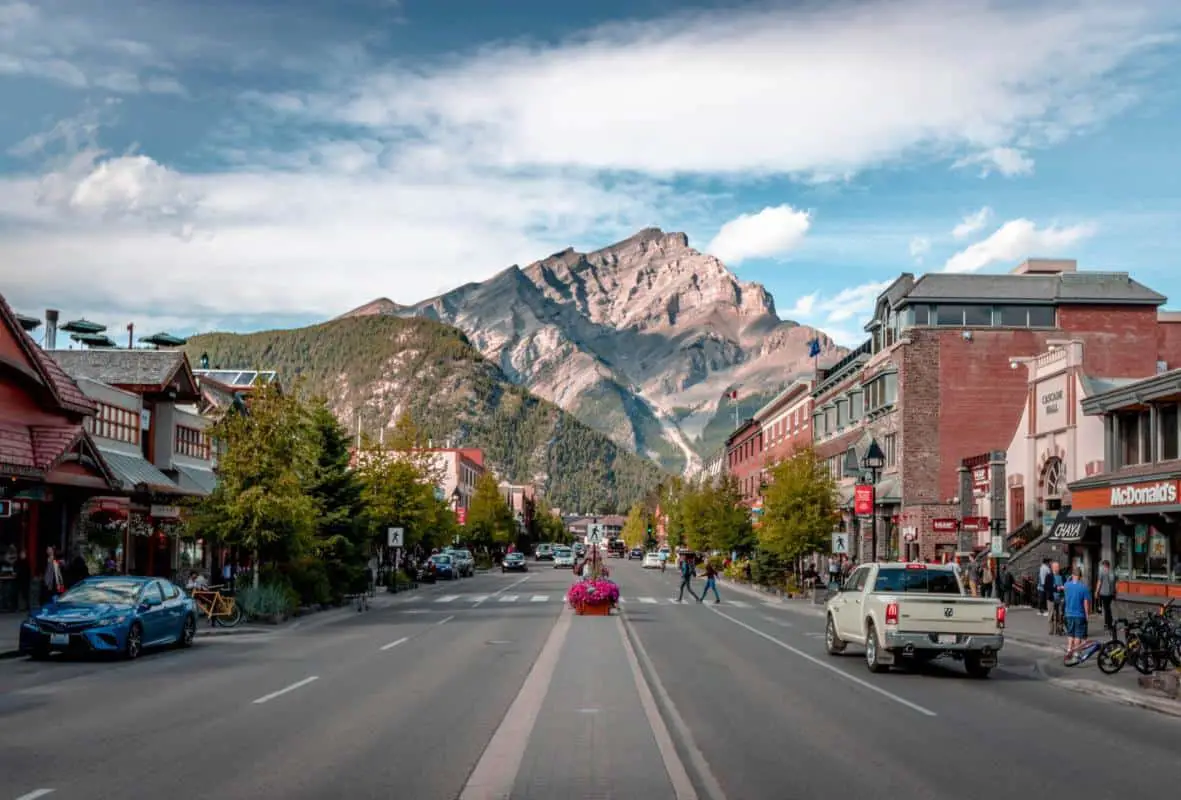
Anyone visiting Banff National Park cannot avoid Banff. The little town in the Rocky Mountains is an attraction in itself because of its enchanting setting, its hundreds of accommodations, its extensive shopping and its large number of restaurants. Although Banff serves as a base for tourists during their exploration of the park, there is more than enough to see in the town itself.
FAST FACTS
Location: 51°10′41″N 115°34′19″W
Altitude: 1383 m (4537 ft)
Number of residents: 7847 (2020)
Surface area: 4.77 km2 (2.94 sq mi)
Coordinates: 51°10′41″N 115°34′19″W
Banff, Alberta’s second-highest community after Lake Louise, is a Unesco World Heritage Site and is one of Canada’s most popular tourist destinations. Many hundreds of thousands of visitors from around the world flock to Banff each summer for its incredible natural beauty.
But it is also a sought-after destination in winter. Ski Norquay, Sunshine Village, and – a little further away – Lake Louise are in the immediate vicinity. In addition, in the coldest months, you can visit many summer tourist destinations for snowshoeing and cross-country skiing, for example. But this enchanting town has much more to offer. Let’s have a look at all things Banff.
LOCATION OF BANFF
Banff is located in the Bow Valley on the Bow River, about 126 kilometers (78 miles) west of Calgary, near the border with British Columbia. The nearest towns are Lake Louise to the north at 57 kilometers (35 miles) and Canmore to the south at 25 kilometers (15.43 miles).
Banff is built at the foot of Cascade Mountain, the iconic mountain that rises at the “end” of Banff Avenue. Other iconic mountains that dominate the view around town include Mount Norquay to the north, Sulphur Mountain to the south, Rundle Mountain to the southeast and the modest Tunnel Mountain to the east.
HISTORY OF BANFF
Banff was founded in 1883 near the site where the Canadian Pacific Railroad (CPR) planned to build a tunnel. The settlement was called Siding 29, the 29th siding from Medicine Hat in eastern Alberta, near the waterfall of Cascade Mountain.
Soon several stores rose north of the railroad, toward Cascade Mountain. It wasn’t long before an overnight accommodation was built: the Alpine Motel. All buildings consisted of wooden structures, hastily built along the railroad or on the road leading away.
A Railroad through the Rocky Mountains
Two years earlier, the railroad company had arrived in the area. It was on its mission to build a railroad through the Rocky Mountains, heading west. The route was determined using information from Canadian government reconnaissance teams. These had been visiting the area since the 1880s to map possible routes.
In 1883, CPR’s vice president Cornelius Van Horne visited Lake Louise. He was impressed with the lake. After returning to Canada’s capital, Ottawa, he spoke with William Pearce, superintendent of mines in the area. He proposed the creation of a system of national parks. Van Horne got little hearing in Ottawa and despite his frantic efforts to get it done, it didn’t happen.
That same year, co-founder of CPR Lord Strathcona (Donald Smith) is said to have renamed Siding 29 as Banff, after the town of his ancestors in Scotland. All that is certain about this is that this name change occurred in 1883. Other sources attribute the origin of the name to George Stephen, president of the CPR. His ancestors also came from near Banff, Scotland.
Meanwhile, Pearce had not let go of Van Horne’s suggestion in Ottawa. He visited the Rockies for the first time in 1884, and, like Van Horne, he was impressed by what he found. At the sight of all of CPR’s activities in the area, he feared that the company would build power plants and destroy the landscape.
Pearce also felt the need to create a national park. A year later, he found a sympathetic ear with Thomas White, Canada’s Minister of the Interior.
Banff Hot Springs Reserve
After Pearce had once again visited the Bow Valley and “discovered” the Hot Springs on his own, he was summoned to Ottawa by White in November 1885. Their conversation led to the establishment of the Banff Hot Springs Reserve, a 26 km2 (10 sq mi) area around the three hot springs in Banff, on November 25, 1885.
The government wanted justification for a national park in the Banff area. Therefore White and Pearce proposed building a townsite and a spa near the hot springs. People would want to come to Banff for it, they reasoned. George Alexander Stewart, surveyor and civil engineer, was appointed superintendent of the park and townsite.
Rocky Mountains Park
In February 1886, Stewart traveled to Banff and plotted two sites, on the Bow River banks and Lake Minnewanka. It soon became clear that the hot springs would be the centerpiece of the new park and which site would be developed. The area designated as a national park was called Rocky Mountains Park.
Banff had its first hotels with the Brett Sanitorium (on the south side of the Bow River – half hotel and half hospital) and the Moulton Park Hotel (built on today’s Central Park).
Meanwhile, the train station made it possible to bring tourists to Banff. It was the only way to get to Banff, and the CPR would like to keep it that way. The village was difficult to reach and therefore exclusive. Banff was growing into the domain of the wealthy. An image only confirmed by constructing the luxurious Banff Springs Hotel in 1888.
With the constant and slowly growing influx of tourists, entrepreneurs saw their opportunities in the new town in the Rockies. Banff gradually increased in size. Streets were laid out, houses, hotels and stores were built, and in 1907 the Province of Alberta began building the Calgary-Banff Highway. When it was completed in 1911, Banff was finally accessible by car.
From 1913 Banff also had a school. When in 1939 the Administration Building was built, the further development of the city was seriously accelerated.
City Rights for Banff
In the following years, tourism grew slowly but surely, and Banff built a tremendous international reputation. With the growth of Calgary Airport – especially starting in 1977 – it became increasingly easy to travel to Banff.
In 1990, Banff finally received city rights. This made it the only municipality in a national park in Canada. Before that, Banff was administered by Canada’s system of national parks. Today, Banff is one of the most popular tourist destinations in Canada. Every year more than four million people visit the photogenic town in the Rockies.
If you want to know more about the background of the park, I recommend reading the post Four Free Banff Documentaries to Watch Right Now.
ACCESSIBILITY OF BANFF
Banff is located right on the Trans-Canada Highway (Highway 1). Running parallel to it is the CPR railroad with a station in Banff. The nearest major airport is Calgary, allowing for a direct drive to Banff by (rental) car. You just have to follow the signs for Highway 1. The road is well-marked in Calgary, so you don’t need navigation.
There is some parking space in Banff itself, but pay parking has been introduced in many parts of the city. It is therefore advisable to leave the car at your hotel or bed and breakfast. In Banff, almost every street is easily accessible on foot. In addition, there is (free) public transportation. It can take you to some of the top attractions within the town and beyond.
I wrote a post about everything you need to know about parking in Banff National Park. Check it out if you want to know more about what’s up with parking in the park.
Public Transportation to and around Banff
If you don’t have a (rental) car, you can use public transportation, operated by Roam Public Transit. This bus service will take you just about anywhere within the community of Banff and to several destinations in the Bow Valley.
Roam Public Transit has nine routes. You can ride to destinations like Sulphur Mountain (including the Banff Gondola and Hot Springs), Cave and Basin, Tunnel Mountain, Lake Minnewanka, Canmore, Johnston Canyon and even Lake Louise.
All buses are wheelchair accessible. They are also equipped with a bike rack. Furthermore, Roam Public Transit’s buses allow you to take strollers, skis and snowboards.
You can pay in different ways on the bus. The driver accepts both Canadian and American bills and coins. Furthermore, you can pay with so-called Roam tokens and tickets. Day passes, or one-month, three-month or six-month passes are also available.
If you want to know when the next bus will arrive at the stop near you, visit the website of Roam Transit.
More information:
Bow Valley Regional Transit Services Commission
Address: 221 Beaver Street, Banff
Phone: +1 403 – 762 0606
Website: roamtransit.com
E-mail: info@roamtransit.com
Public Transportation from Calgary to Banff and from Banff to Calgary
If you have just arrived at Calgary airport, you can continue your journey with public transport. Several transportation companies have scheduled service to Banff.
Banff Airporter
Banff Airporter operates a shuttle bus from Calgary Airport to Banff and vice versa five times a day. It is also possible to travel to Canmore. In addition, Banff Airporter offers private transfers for individuals or groups under the name Banff Sedan. Check the website for the variety of options and their rates.
Fares:
Adult (18-64): CAD 72.99 – return: CAD 145.98
Seniors (65+): CAD 65.69 – return: CAD 131.38
Children (6-17): CAD 36.50 – return: CAD 72.99
Children under 5: free – return: free
Banff Airporter
Address: 141 Eagle Crescent, Banff
Phone: +1 888 – 449 2901 (toll free) / +1 403 – 762 3330 (local)
Website: banffairporter.com / banffsedan.com
E-mail: info@banffairporter.com / info@banffsedan.com
Banff Express
This service does not have a pick-up location at Calgary Airport, but it has three pick-up locations in the city. Banff Express stops in Banff and in Canmore and is one of the cheapest options. The service runs twice a day, once in the morning and once in the late afternoon. Tickets can be booked online. You can’t book round-trip tickets, but you can book two one-way tickets.
Fares:
Adults: CAD 40 (Banff) / CAD 35 (Canmore)
Children (up to age 12): CAD 22 (Banff) / CAD 22 (Canmore)
Banff Express
Phone: +1 403 – 604 7466
Website: thebanffexpress.com
E-mail: via the website
Brewster Express
Brewster has been a household name in the Rockies for decades. Additionally, the company provides private transfers, but at a higher cost. The Brewster shuttle connects Calgary to Banff, Canmore, Kananaskis, Lake Louise, and Jasper.
Fares:
Adults: CAD 74 – return: CAD 126
Children: CAD 37 – return: CAD 67
Children (0-6 years): free* – return: free
* If the child shares a seat with an adult
Brewster Express
Address: 100 Gopher Street, Banff
Phone: +1 877 – 625 4372
Website: https://www.banffjaspercollection.com/brewster-express
E-mail: Through form on website
Discover Banff Tours
Discover Banff Tours has a shuttle bus service from Calgary Airport and Calgary downtown to Canmore, Banff and Lake Louise. It sells one-way trips only. You can book them online. Discover Banff Tours also offers (much pricier) private transfers for individuals or groups. In this case, you can choose the type of car you want to travel in. Discover Banff Tours asks that you call for a quote for this option.
Fares:
Adult (16+): CAD 74
Children (6-15): CAD 37
Children (0-5): Free
Discover Banff Tours
Address: 215 Banff Avenue, Banff (in the Sundance Mall)
Phone: +1 403 – 760 5007
Website: banfftours.com
E-mail: info@banfftours.com
On-It Regional Transit
On-It Regional Transit allows you to travel from Calgary to Banff and Canmore from May through September. The service is available Friday through Sunday and on national holidays (Canada has quite a few). In Banff, an On-It Regional Transit ticket allows you to transfer for free to a Roam Public Transit bus for local transportation in and around Banff.
On-It Regional Transit has three stops in Calgary to travel to Banff and/or Canmore. The stop closest to the airport can be found on 9th Avenue Southeast in downtown Calgary, behind the Olympic Plaza.
Fares:
CAD 10 per person
On-It Banff & Canmore
Phone: +1 587 – 534 0542
Website: onitregionaltransit.ca
E-mail: onitsupport@southland.ca
Rocky Mountain Shuttle
Rocky Mountain Shuttle is a personal transportation service available 24 hours a day. This company also provides group transportation. You can travel to Canmore, Banff, and Lake Louise using Rocky Mountain Shuttle. Reservations are necessary. For this, you can make a call, shoot them a message through Whatsapp, or send a message using the website.
Fares:
Calgary to Banff: CAD 205 per car
Rocky Mountain Shuttle
Address: 60 Glendale Way, Cochrane, AB
Phone: +1-403 – 829 2667
Website: rockiesshuttle.ca
E-mail: via the website
Taxi Services in Banff
Banff has two cab services:
- Banff Taxi (+1 403 – 762 4444)
- Taxi Taxi (+1 403 – 762 0000)
Both are available 24/7. Transportation of (larger) groups is also possible.
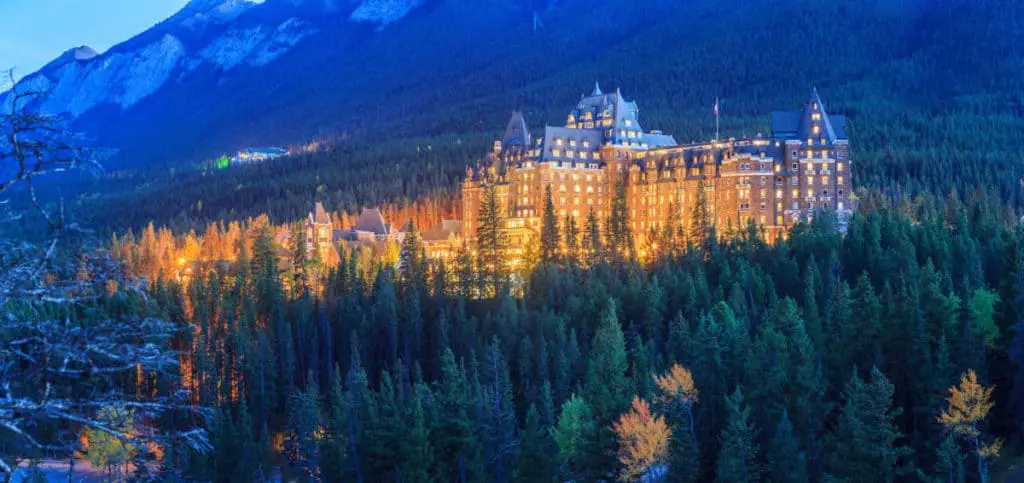
Traveling to Banff by electric car? In that case I highly recommend reading the post with all ins and out about Banff by EV.
LODGING IN BANFF
Banff has dozens of hotels, motels, bed and breakfasts and three hostels. The most imaginative hotel is the imposing and world-famous “fairytale hotel” Fairmont Banff Springs, at the foot of Rundle Mountain. Staying at this beautiful hotel is certainly not cheap. Keep in mind CAD 750 (!) or more per night.
If you find that too expensive, it is still worth a visit. The hotel has a beautiful lobby with an impressive vault and a beautiful staircase. And of course, you can eat and drink in the various bars and restaurants. You will also find the necessary stores.
The Rimrock Hotel on the flanks of Sulphur Mountain is an excellent place to spend the night, as are the many other accommodations in Banff itself. Regardless of the hotel, the view is always stunning. It’s up to you how much luxury you prefer.
Low budget Accommodations in Banff
If you have a little less budget and still want to stay in Banff, there are three hostels (Banff International Hostel, Same Sun Banff and HI Banff Alpine Center). Although low budget doesn’t quite apply here either. In high season you easily pay CAD 150 per night. Still, it is much cheaper than the average hotel price. That is around CAD 350.
Book in Time
Although the supply of accommodations is enormous, it is advisable to book in time. To give you an idea: in 2019 (before corona), over four million people visited Banff National Park. So you can imagine that hotels get booked up quickly in high season.
If you want to know more about hotels in Banff I highly recommend you read the The Ultimate Overview of Hotels in Banff
Camping in Banff
It is possible to camp in Banff. The townsite has a huge campground at the foot of Tunnel Mountain, divided into three locations, with plenty of room for tents and RVs. Anyone wishing to build a campfire must have a permit to do so. Permits are available at the campground.
Tunnel Mountain Village I Campground
Address: Tunnel Mountain Road, Banff
Phone: +1 877 – 737 3783
Overnight stay: upon availability, reservations are possible
Number of sites: 618
Facilities: camp kitchens, picnic tables, fire pits, firewood, hot showers, flush toilets, handicap access, sani dump
Campfire permit: available at the campground
Kind of accommodations: motor homes and tents
Distance to Banff center: 5.4 km (3.35 mi)
Tunnel Mountain Village II Campground
Address: Tunnel Mountain Road, Banff
Phone: 1 877 – 737 3783
Overnight stay: subject to availability, reservations possible
Number of sites: 188
Facilities: camp kitchens, picnic tables, fire pits, firewood, hot showers, flush toilets, handicap access, sani dump
Campfire permit: available at the campground
Kind of accommodations: motor homes and tents
Distance to Banff center: 3 km (1.86 mi)
Tunnel Mountain Trailer Court Campground
Address: Tunnel Mountain Road, Banff
Phone: +1 877 – 737 3783
Overnight stay: upon availability, reservations are possible
Number of sites: 321
Facilities: camp kitchens, picnic tables, fire pits, firewood, hot showers, flush toilets, handicap access, sanidump
Campfire permit: available at the campground
Kind of accommodation: motorhomes
Distance to Banff center: 3.3 km (2.05 mi)
If you want to know more about camping in Banff I highly recommend you read the post The Ultimate Overview of Campgrounds in Banff National Park
BEST PERIOD TO VISIT BANFF
The Banff townsite is the center of the park. Therefore, the summer and winter high seasons are best to visit. Banff has a lot to offer, so even in the “lesser” months of November and April, you can have a great time there.
The summer months of July and August provide the best weather. All lakes will have thawed, and all tourist attractions are open. The disadvantage is that Banff is by far the busiest in those months. It means it can be challenging to book a hotel. And Banff Avenue can be so busy that you can’t do much more than shuffling. Especially in the late afternoon and early evening.
If you’re lucky you can see the northern lights in Banff. Want to know more about it? Then I recommend reading the post See the Northen Lights in Banff.
MUSEUMS IN BANFF
In Banff, there are quite a few opportunities if you want to know more about the history of the park, the Rockies and the (culture of) the park’s first nations. There are several museums, all within walking distance of each other.
Banff Park Museum
The Banff Park Museum is housed in a 1903 log cabin of sorts. The property is protected as a National Historic Site and is the oldest natural history museum in western Canada. In the museum, you will find plenty of information about the history of flora and fauna in Banff National Park. The building’s architectural style is typical of the early federal buildings in the park.
Admission fees:
Adults: CAD 4.25
Seniors (65+): CAD 3.75
Youth: free
Commercial group, per person: CAD 3.75
Address: 91 Banff Avenue
Phone: +1 403 – 762 1558
Website: pc.gc.ca/en/lhn-nhs/ab/banff
Buffalo Nations Luxton Museum
The Buffalo Nations Luxton Museum shows you the heritage of the First Nations who lived in the area for centuries. You’ll learn about their way of life, illustrated through numerous artwork exhibits, weapons, tools, clothing and ceremonial items.
Admission fees:
Adults: CAD 10.00
Seniors (65+): CAD 9.00
Youth (7-17): CAD 5.00
Children up to 7 years: free
Address: 1 Birch Avenue
Phone: +1 403 – 762 2388
Website: buffalonationsmuseum.com
Historic Luxton Home
The Historic Luxton Home tells the story of Norman Luxton, Georgina McDougall Luxton and their daughter Eleanor. They formed a pioneer family in Banff that lived there for ninety years, spread over several generations.
In the museum, you get a glimpse into the life of this family. Because many items of Norman, Georgina and Eleanor are on display, you get a good idea of life in the early days of Banff. The adjacent Luxton Garden, designed and laid out in the Arts and Craft Style around 1910, features 120-year-old lilac trees.
Admission fees:
Adults: CAD 10.00
Seniors (65+): CAD 9.00
Youth (7-17): CAD 5.00
Children up to 7 years: free
Address: 206 Beaver Street
Phone: + 1 403 – 762 2105
Website: –
Whyte Museum Of The Canadian Rockies
The Whyte Museum Of The Canadian Rockies strives to make the history and culture of the Rocky Mountains accessible. The museum was founded by the couple Peter and Catharine Whyte. Among other things, you’ll find art exhibits and an extensive collection of original artwork and photographs.
Admission fees:
Adults: CAD 10.00
Seniors (65+): CAD 9.00
Students and locals (from Lake Louise to Morley): CAD 5.00
Children under 12: free
Museum members: free
Address: 111 Bear Street
Phone: +1 403 – 762 2291
Website: whyte.org
ART IN BANFF
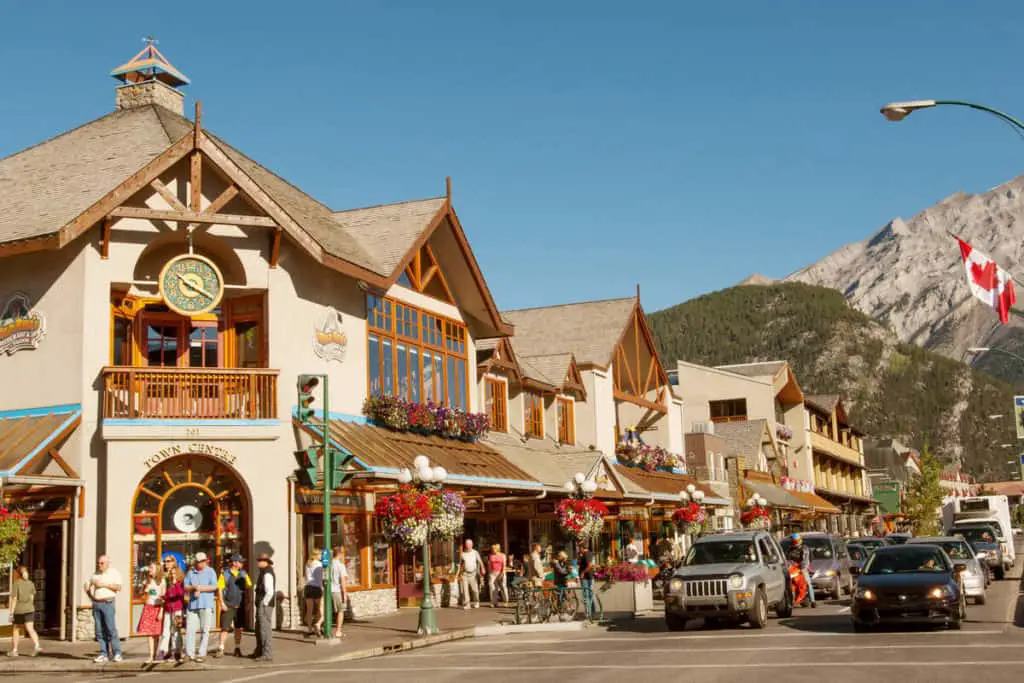
If you enjoy viewing art or perhaps want to buy a piece of art, Banff is the place to be. You’ll find a wide range of artwork, paintings and photography, including local (native) artists.
Banff National Park has produced much of its own art over the past few decades, inspired by this remarkable region. For art and photography lovers, this can make visiting one of the many galleries extra valuable.
Below is a listing of galleries. The level of art and photography varies. Some galleries have [many other products to souvenirs and a hair salon with art by local artists on the wall]. But you can find something interesting everywhere.
ABOUT CANADA
Address: 105 Banff Avenue
Phone: +1 403 – 760 2996
Website: aboutcanada.ca
ALL IN THE WILD GALLERY
Address: 105 Banff Avenue
Phone: +1 403 – 760 3141
Website: allinthewild.com
BOTEGA SALON & GALLERY
Address: Bison Courtyard, 211 Bear St. #105
Phone: +1 403 – 760 3087
Website: botegahair.com
BRANDON T. BROWN
WILDERNESS GALLERY
Address: 211 Bear Street
Phone: +1 403 – 953 0119
Website: brandontbrown.com
CANADA HOUSE GALLERY
Address: 201 Bear Street
Phone: +1 403 – 762 3757
Website: canadahouse.com
CARTER-RYAN GALLERY
Address: 229 Bear Street
Phone: +1 403 – 621 1000
Website: carter-ryan.com
EDITIONS GALLERY
Address: Cascade Shops, 317 Banff Avenue
Phone: +1 403 – 760 2955
Website: –
MOUNTAIN GALLERIES AT THE FAIRMONT
Address: Banff Springs Hotel, 405 Spray Av.
Phone: +1 403 – 760 2382
Website: mountaingalleries.com
THE QUEST GALLERY
Address: Banff Springs Hotel, 405 Spray Av.
Phone: +1 403 – 76222
Website: thequestgallery.com
SIDESHOW GALLERY, SHOP & DARKROOM
Address: 111 Banff Avenue, #105
Phone: –
Website: sideshowgallery.ca
WALTER PHILLIPS GALLERY
Address: 107 Tunnel Mountain Drive
Phone: +1 403 – 762 6281
Website: banffcentre.ca/walter-phillips-gallery
WILLOX & SAX GALLERY
Address: 210 Bear Street
Phone: +1 403 – 762 2214
Website: willoxandsaxgallery.com
Want to see where and how to get discounts? Read the post about all kinds of discounts you can get in the park
ACTIVITIES IN AND AROUND BANFF
You never have to be bored in Banff, even in the off-season. There is an almost infinite number of beautiful places you can visit in the summer. And of course, you can do plenty of hiking, golfing, biking, mountain biking, rafting and fishing. In winter, there are some excellent snowshoe trails. Furthermore, you can ice skate at Vermilion Lakes, you can cross-country ski around Banff and ski at one of the three slopes in the area.
Hikes around Banff
Because Banff is in the middle of the Bow Valley, there are lots of opportunities for hiking near the town. And there is something for everyone, from easy, short routes to more difficult, long routes. Below is an overview of the most popular hikes.
Easy
| TRAIL | DISTANCE (round trip) | DURATION | ELEVATION | TRAILHEAD |
|---|---|---|---|---|
| Boulder Pass | 17.2 km (10.62 mi) | 6 – 7 hrs | 640 m (2100 ft) up | Fish Creek car park at Whitehorn Road, 3 km north of Lake Louise |
| Fairview Mountain | 10.2 km (6.30 mi) | 5 – 6 hours | 1013 m (3323 ft) ascent | Upper Lake Louise car park |
| Paradise Valley and Giant Steps | 20.6 or 21.8 km (12.72 or 13.46 mi) | 7 – 8 hours | 385 m (1263 ft) up | follow Moraine Lake Road for 2.5 km (2.5 mi) until you see a parking area on your right |
| Saddleback | 7.4 km (4.57 mi) | 3 – 4 hrs | 595 m (1952 ft) ascent | Upper Lake Louise car park |
| Sheol/Paradise Connector | 8.1 km (5 mi) | 4 – 6 hours | 588 m (1929 ft) ascent | Upper Lake Louise car park |
| Tramline | 9 km (5.55 mi) | 2 – 4 hrs | 500 m (164 ft) ascent | Upper Lake Louise car park or follow Moraine Lake Road to Paradise Valley car park on your right |
Moderate
| TRAIL | DISTANCE (round trip) | DURATION | ELEVATION | TRAILHEAD |
|---|---|---|---|---|
| Bourgeau Lake | 15 km (9.32 mi) | 6 hours | 725 m (2379 ft) | Bourgeau Lake parking lot |
| Cascade Amphitheatre | 15.4 km (9.57 mi) | 6 hours | 640 m (2100 ft) | the kiosk at the south end of the Mount Norquay ski area parking lot |
| C-Level Cirque | 7.8 km (4.85 mi) | 3 hours | 455 m (1493 ft) | B Upper Bankhead Day-use Area |
| Harvey Pass | 19.4 km (12.05 mi) | 7-8 hrs | 1020 m (3346 ft) | Bourgeau Lake parking lot |
| Healy Creek | 17.6 km (10.94 mi) | 6-7 hrs | 655 m (2149 ft) | Sunshine Village parking lot behind the main lift building |
| Stoney Lookout | 4.2 km (2.61 mi) | 1.5 hours | 190 m (623 ft) | the kiosk at the south end of the Mount Norquay ski area parking lot |
| Sulphur Mountain | 11 km (6.83 mi) | 4 hours | 655 m (2149 ft) | Banff Upper Hotsprings parking lot |
| Surprise Corner to Hoodoos Viewpoint | 9.6 km (5.96 mi) | 3 hours | 115 m (377 ft) | Surprise Corner on the east side of Buffalo Street |
| Tunnel Mountain Summit | 4.8 km (2.98 mi) | 2 hours | 260 m (853 ft) | the lower parking lot on St. Julien Road |
Difficult
| TRAIL | DISTANCE (round trip) | DURATION | ELEVATION | TRAILHEAD |
|---|---|---|---|---|
| Cory Pass Loop | 26 km (16.15 mi) | 6 hours | 915 m (3002 ft) | Fireside Day-use Area on the Bow Valley Parkway |
If you want to do some hikes near the town of Banff I highly recommend reading the post 11 Easy Hikes Near the Town of Banff.
Mountain Biking in the Banff Area
The Rocky Mountains around Banff are ideal for having a good time on a mountain bike. Challenge enough, there are plenty of trails, and the reward is always a great view. The trails range from easy (and accessible for families) to difficult. Below is an overview of the mountain bike trails near Banff.
Easy
| TRAIL | DISTANCE (round trip) | ELEVATION | TRAILHEAD |
|---|---|---|---|
| Banff Legacy Trail | 38 km (23.46 mi) | 24 m (79 ft) up / 113 m (371 ft) down | Valleyview, Cascade Ponds, Vermilion Lakes and Fir |
| Healy Creek | 5.5 km (3.39 mi) | 95 m (311 ft) up / 100 m (328 ft) down | Healy/Brewster parking lot |
| Spray River Loop | 11.3 km (6.97 mi) | 242 m (794 ft) up / 247 m (810 ft) down | Bow Falls parking lot |
| Sundance Trail | 7.4 km (4.57 mi) | 75 m (246 ft) up / 60 m (196 ft) down | Cave and Basin National Historic Site |
| Tunnel Mountain Campground Loop | 6.2 km (3.83 mi) | 68 m (223 ft) up / 68 m (223 ft) down | Hidden Ridge Way, at the Hidden Ridge Resort |
| Water Tower | 17 km (10.49 mi) | 280 m (918 ft) climbing / 110 m (361 ft) descending | Cave and Basin National Historic Site of Healy/Brewster parking lot |
Moderate
| TRAIL | DISTANCE (round trip) | ELEVATION | TRAILHEAD |
|---|---|---|---|
| Banff Avenue Trail | 6.6 km (4.07 mi) | 65 m (213 ft) up / 50 m (164 ft) down | East side of Banff Avenue at the intersection with Legacy Trail or Tunnel Mountain Road |
| Bow Falls Hoodoos Trail | 9.4 km (5.80 mi) | 18 m (59 ft) up / 18 m (59 ft) down | Tunnel Mountain Road, trailhead Tunnel Mountain Trail |
| Brewster Creek 17 km | 17 km (10.49 mi) | 280 m (918 ft) up / 110 m (361 ft) down | Cave and Basin National Historic Site of Healy/Brewster parking lot |
| Middle Springs | 7 km (4.32 mi) | 124 m (407 ft) up / 124 m (407 ft) down | Spray River West trailhead, or Sulphur Mountain |
| Spray River and Goat Creek | 37.4 km (23.08 mi) | 435 m (1427 ft) up / 160 m (525 ft) down | Spray River West trailhead behind the Fairmont Banff Springs Hotel |
| Star Wars Trail | 2.5 km (1.54 mi) | 60 m (196 ft) up / 67 m (219 ft) down | Tunnel Mountain Drive past the reservoir on the left |
| Sulphur Mountain Backside | 15.6 km (9.63 mi) | 885 m (2903 ft) up | Cave and Basin National Historic Site |
| Surprise corner To Hoodoos Viewpoint | 9.6 km (5.93 mi) | 115 m (377 ft) up / 90 m (295 ft) down | Hoodoos, or the Surprise Corner parking lot |
| Tunnel Bench Loop | 9.7 km (loop) (5.99 mi) | 49 m (161 ft) up / 45 m (147 ft) down | Hoodoos parking lot or the Tunnel Mountain Campground |
| Tunnel Technical Trails | 2.7 km (1.67 mi)(loop) | 80 m (262 ft) up | Tunnel Mountain Drive at the reservoir |
Difficult
| TRAIL | DISTANCE (round trip) | DURATION | ELEVATION | TRAILHEAD |
|---|---|---|---|---|
| Boulder Pass | 17.2 km (10.62 mi) | 6 – 7 hrs | 640 m (2100 ft) up | Fish Creek car park at Whitehorn Road, 3 km north of Lake Louise |
| Fairview Mountain | 10.2 km (6.30 mi) | 5 – 6 hours | 1013 m (3323 ft) ascent | Upper Lake Louise car park |
| Paradise Valley and Giant Steps | 20.6 or 21.8 km (12.72 or 13.46 mi) | 7 – 8 hours | 385 m (1263 ft) up | follow Moraine Lake Road for 2.5 km (2.5 mi) until you see a parking area on your right |
| Saddleback | 7.4 km (4.57 mi) | 3 – 4 hrs | 595 m (1952 ft) ascent | Upper Lake Louise car park |
| Sheol/Paradise Connector | 8.1 km (5 mi) | 4 – 6 hours | 588 m (1929 ft) ascent | Upper Lake Louise car park |
| Tramline | 9 km (5.55 mi) | 2 – 4 hrs | 500 m (164 ft) ascent | Upper Lake Louise car park or follow Moraine Lake Road to Paradise Valley car park on your right |
Golfing in Banff
Banff has its own 27-hole golf course, designed in 1928 by renowned golf course architect Stanley Thompson. With the impressive Rocky Mountains and Bow River as a backdrop, I would venture to say that this is one of the most beautiful golf courses you will ever play on. Oh, and don’t be surprised if you see a wapiti, moose or caribou on the green.
Although the course is part of the Fairmont Banff Springs Hotel, you don’t have to be a guest there to play. You can book your tee time on the hotel’s website or at banffmountaingolf.com. You can choose to play 9 holes (par 35) if you find 18 (par 71) holes too much. Clubs, balls and also golf shoes can be rented on site.
Golf Packages at Banff Golf Course
Various packages are available. You can play as an individual or in small groups. Still, also larger groups are welcome, such as wedding guests and team outings, for example. You can even book fully catered golf vacations.
Heritage Golf Experience
You can participate in the Heritage Golf Experience if you like to experience what it was like to play golf on the course as conceived by Thompson in 1928. During this memorable golf experience, you will play with the original golf equipment of the time.
Learning to Play Golf in Banff
Would you like to walk around the beautiful greens of the Fairmont Banff Springs but can’t play golf yet? Then participating in the Fairmont Banff Springs Golf Academy is a good idea. This golf school offers a wide range of instructional programs.
More information: +1 403 – 762 1765
Moving about the Banff Golf Course
You can complete the holes on foot just fine, but because of the length of the course, many golfers use an electric golf cart. This is included in the green fee. For guests of the Fairmont Banff Springs hotel, there is a continuous shuttle service between the clubhouse and the hotel.
Fairmont Banff Springs Golf Course
Address: Golf Course Road, Banff
Season: 9-hole course – May through October
18-hole course – June through October
Want to know more about golfing in Banff National Park? Click the link!
Canoe, Kayak or Paddleboard Rentals in Banff
You can explore the Bow River and Vermilion Lakes from the water in Banff. To do so, you can rent a canoe, kayak or standup paddleboard (SUP) from The Banff Canoe Club at the corner of Wolf Street and Bow Avenue, in Banff town. Rentals are by the hour, on a first-come, first-served basis. Via Forty Mile Creek, you can sail on Vermilion Lakes. You can also explore Echo Creek.
Bring Your Own Canoe, Kayak or Paddleboard
It is also possible to use your own canoe, kayak or paddleboard. You can put those in the water at the corner of Wolf Street and Bow Avenue. The canoe docks are municipal recreation facilities and are open to the public.
The Banff Canoe Club
Address: corner of Wolf Street and Bow Avenue
Phone: +1 403 – 762 5005
Website: banffcanoeclub.com
E-mail: info@banffcanoeclub.com
Rafting in Banff
There are several places in Banff where you can book a rafting adventure in the Rockies. But there is only one that does it in the Bow River right near Banff. That’s Rocky Mountain Raft Tours. The tour starts on Golf Course Road, just around the corner from Bow Falls. The tours include guides and equipment.
The location has its own parking lot that can accommodate about forty cars. The site is also easily accessible on foot.
Rocky Mountain Raft Tours
Address: 1 Golf Course Road, Banff
GPS: Latitude 51.164444 | Longitude -115.556944
Phone: +1-403 – 762 3632
Website: banffrafttours.com
E-mail: info@banffrafttours.com
Want to know more about rafting in Banff National Park? Click the link!
Fishing in Banff
Fishing is allowed in the Bow River and neighboring Vermilion Lakes. You do need a national park permit to do so. This is available at the visitor center in Banff, most sporting goods stores in town and also online. In addition, a national park pass is required. A fishing license from the province of Alberta is not sufficient.
Any angler under the age of sixteen may fish in the lake without a permit if accompanied by someone under sixteen who holds a national park permit. The maximum number of fish to be caught is equal to the limit of the license of the person holding this license.
Note: Captured fish must be returned to the location where it was caught.
Fish Species in the Bow River
Fish in the Bow River include brown trout, Rocky Mountain whitefish, redthroat trout, bull trout, and brook trout.
Please note that natural bait is not allowed in Banff National Park.
Fly Fishing in the Bow River
In the wilderness of the Rocky Mountains around Banff, fly fishing is perhaps the most popular method of fishing. The Bow River lends itself perfectly to this.
Of course, summer is the time to fish, but it is also possible to fish in the Bow River during the winter months. This is possible thanks to the so-called “chinooks”, warm winds that blow through the Rockies. It also allows you to enjoy nature in its winter coat. And that might be just as beautiful as its summer coat.
Skiing in Banff
Winter is also a great time of year to visit Banff National Park. The park offers numerous opportunities for winter sports, of which skiing and snowboarding are obviously the most popular. Near Banff are two major ski slopes, Mt Norquay and Sunshine Village. If you find sixty kilometers of driving not far, Lake Louise Ski Resort is also relatively close. Hundreds of thousands of ski enthusiasts know how to find them each year.
Mt Norquay
The ski slopes of Norquay Mountain are located 7.5 kilometers (4.63 mi) north of Banff on the Trans-Canada Highway (Highway 1). It is the closest ski slope to Banff. Mt Norquay has 6 ski elevators and 60 ski slopes in the ski area formed in its entirety by Mount Norquay. The slopes of Mt Norquay cover an area of 0.77 km2 (0.30 sq mi). The summit is at 2133 m (6998 ft), the base is at 1630 m (5348 ft). Mt Norquay also has a snowboard park.
More information:
Phone: +1 844 – 667 7829
Website: banffnorquay.com
Sunshine Village
The ski slopes of Sunshine Village are located 8 kilometers (4.94 mi) west of Banff on the Trans-Canada Highway (Highway 1). The area is known for getting the most snow of the three ski areas in Banff National Park because of its location on the edge of a continental divide.
There are 9 ski elevators and 120 ski runs in the ski area formed by Mount Standish, Lookout Mountain and Goat’s Eye Mountain. The slopes of Sunshine Village cover an area of 3.59 km2 (1.38 sq mi). The summit is at 2,730 m (8957 ft), the base is at 1,660 m (5446 ft).
More information:
Phone: +1 877 – 542 2633
Website: skibanff.com
Cross-Country Skiing in Banff
In winter, the immediate area around Banff lends itself perfectly to cross-country skiing. You can enjoy the winter coat of the Rockies on the long skis in relative peace, provided you stay away from the ski slopes, of course. Below are some popular trails.
| TRAIL | DISTANCE | ELEVATION | TRAILHEAD |
|---|---|---|---|
| Brewster Creek | 22.2 km (13.70 mi) | 315 m (1033 ft) up / 150 m (492 ft) down | Healy/Brewster parking lot on the road to Sunshine Valley |
| Castle Junction | 10 km (6.17 mi) | Minimal | Parking lot off the HI Hostel road, south of Castle Junction |
| Healy Creek | 11 km (6.79 mi) | 95 m (312 ft) up / 100 m (328 ft) down | Cave and Basin National Historic Site, on the west side of the building, beginning on the Sundance Trail |
| Spray River East Trail | 11.2 km (6.91 mi) | 105 m (344 ft) up / 70 m (229 ft) down | Spray River West trailhead, past the Fairmont Banff Springs Hotel |
| Tunnel Mountain Winter Trails | 8 km (4.94 mi) (all trails) | Minimal | Tunnel Mountain Trailer Court Campground entrance |
Snowshoeing in Banff
You can also enjoy the views near Banff in the winter. One such way is snowshoeing. This allows you to walk with relative ease over the thick blanket of snow in the coldest months. Below is an overview of the trails you can walk.
| TRAIL | DISTANCE | DURATION | ELEVATION | TRAILHEAD |
|---|---|---|---|---|
| Sulphur Mountain Westside | 5.6 km (3.46 mi) | 6 hours | 855 m (2805 ft) | Cave and Basin National Historic Site, on the west side of the building, beginning on Sundance Trail |
| Surprise Corner to Hoodoos | 9.6 km (5.92 mi) | 3 – 4 hrs | 115 m (377 ft) | Surprise Corner on the east side of Buffalo Street |
| Tunnel Mountain Drive | 4 km (2.47 mi) | 1 – 2 hrs | 130 m (426 ft) | The locked gate at the intersection of Tunnel Mountain Drive and St. Julien Road, near the Banff Centre |
| Upper Stoney Loop | 4.8 km (2.96 mi) (loop) | 2 hours | 205 m (672 ft) | Kiosk on the south side of the Mount Norquay ski slope parking lot |
MORE INFORMATION
Banff Visitor Centre
Opening hours (daily): 9 am – 5 pm
Address: 224 Banff Avenue, Banff
Phone: +1 403 – 762 1550
E-mail: pc.banff-vrc.pc@canada.ca
Lake Louise Visitor Centre
Opening hours (daily): 9 am – 5 pm
Address: Samson Mall, 201 Village Rd, Lake Louise
Phone: +1 403 – 522 3833
E-mail: pc.lakelouiseinfo-infolakelouise.pc@canada.ca
Other articles you might be interested in:
• How to Make Sure Mosquitoes Don’t Ruin Your Stay in Banff
• Plan Your Banff Itinerary – Know the Distances
• How Much Does a Banff Vacation Cost in 2023? (Crazy Numbers)

